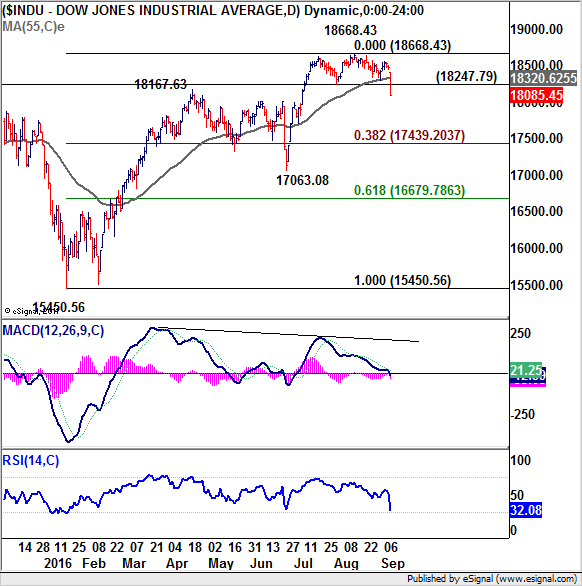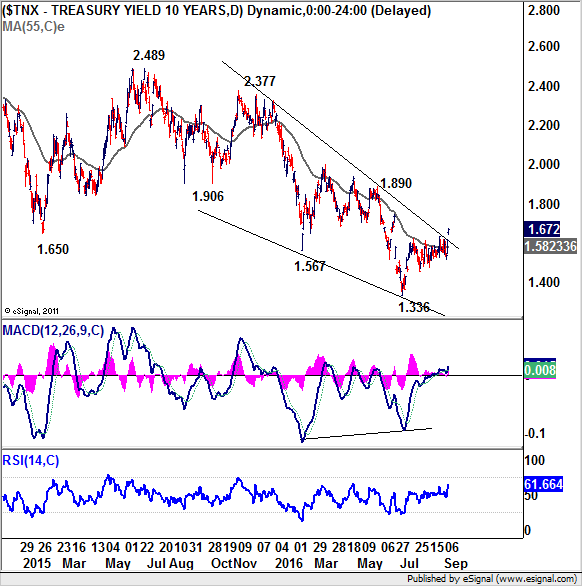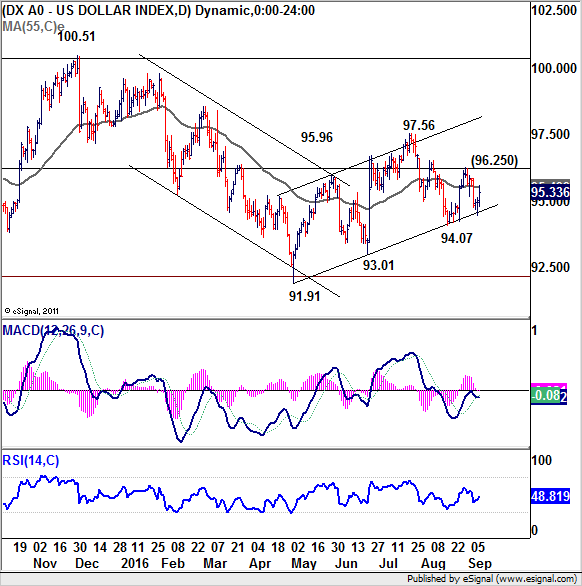Revived speculations of a Fed hike this month rocked the markets towards the end of last week. Equities suffered the worst selloff since Brexit with DJIA losing 394.46 pts, or -2.13% on Friday to close at 18085.45. S&P 500 also lost -53.49 pts, or -2.45%, to close at 2127.81. The sharp falls in both indices carry significant bearish technical implications. Meanwhile, the selloff in stocks was accompanied by surge in treasury yields. As US 10 year yield closed at 1.672, breaking out from recent range, up from prior week's close at 1.596. 30 year yield also rose sharply to close at 2.39, also broke out from recent range, up from prior week's close at 2.271. Dollar index pared back much of the week's loss to close at 95.34. However, as of Friday, fed fund futures were still pricing in only 24% chance of September hike and 59.3% of December hike.
More hawkish than expected comments from a dove Boston Fed president Eric Rosengren that Fed should continue with gradual policy normalization was quoted as a reason for the revived speculation of September hike. Also, there were speculation that Fed governor Lael Brainard, another dove, could change her tone in a speech on Monday. However, it should be noted that the surge in US yield started on Thursday and was indeed by rise in German bund yields after ECB kept monetary policies unchanged. German 10 year yield turned positive on Friday for the first time since Brexit.
Meanwhile the Japanese yen reversed earlier selloff and closed the week mildly higher against all major currencies on talk that BoJ policy makers might not reach an agreement on stimulus expansion in this month's meeting. BoJ governor acknowledged that downsides of negative interest rate last week too. And there were also talks that BoJ has been studying options to steepen the yield curve. That is, lowering short to medium term yields while pushing up long yields. It should no noted that yield curve in Japan flattened after BoJ introduced negative rates in January. And thus, BoJ might just opt for qualitative tweaking of the stimulus, rather than quantitative nor deepening negative rates.
In any case, the consensus is that Fed is still on course for another hike and the question is just the timing. While Fed policy makers still expected to raise rate some time this year, it's likely that they wouldn't prefer to divergence with other major central banks as a fast pace. And the lack of easing of ECB as well as the receding expectation of BoJ easing could give FOMC the room to act in September. And this is seen as the main reason for the revived speculations. But after all, there are still 10 days to go and the expectations could change again.
Technically, the developments in stocks and yield were significant. DJIA's strong break of 18247.79 support completed a small head and should top pattern which confirms short term topping. More importantly, bearish divergence condition in daily MACD argues that rise from 15450.56 has completed at 18668.43 too. Deeper decline is expected in near term to 38.2% retracement of 15450.56 to 18668.43 at 17439.20. The real test lies in 17063.08 support and sustained break there will raise the chance of medium term reversal.

10 year yield broke out from range that started back in July to close strongly at 1.672. It should also be noted that firstly, TNX should have finally conquered 55 days EMA as resistance. Secondly, the medium term falling trendline was also taken out. Thirdly, bullish convergence condition is seen in daily MACD. Fourthly, the decline from 2.489 is apparently in sharp of terminal triangle. Thus, it's likely that the trend is reversing in TNX. 1.89 resistance will likely be tested.

Development in dollar index is less clear as it failed to sustain above 55 days EMA and retreated last week. On the other hand, it's staying inside near term rising channel. Near term outlook stays neutral initially this week first. With Friday's rebound, focus is on 96.25 resistance this week. Break should send the index back to 97.56 resistance. But price actions from 91.91 are not impulsive looking, we'd be cautious on strong resistance from 97.56 to limit upside. Sustained trading above there is needed to confirm underlying momentum. Meanwhile, break of 94.07 will turn focus back to 93.01 support instead.

Regarding trading strategies, our EUR/AUD long was unfortunately stopped by the intra-week dip to 1.4577. However, subsequent strong rebound and break of 1.4887 indicates near term reversal. Hence, we'll buy EUR/AUD at market again this week with a stop at 1.4750. On the other hand, we bought USD/JPY at 102.50 on pull back. Outlook in USD/JPY is a bit mixed and thus, we'll put a tight stop at 101.90 to guard against another selloff in the pair.
